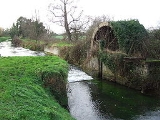
Narborough Bone Mill
Encyclopedia
Narborough Bone Mill was a watermill
that operated on the River Nar
in the west of the English
county of Norfolk. The watermill was 1 miles (1.6 km) downstream of the village of Narborough
. The mill was built in the early part of the 19th century and records show that it was owned by the Marriott Brothers in 1830, who also owned the navigation rights on the river Nar.
by barge from the blubber-processing factory at Lynn. 7.5 miles (12.1 km) to the north on the River Cong
stands Congham watermill. Whales were carried there by horse and cart to be processed. The bones were then carried to Narborough for rendering. Both mills were in remote locations, possibly because of the distinctive smell that would have been prevalent. The fact that Narborough watermill was not near a road did not matter, as both its raw materials and its finished products were carried by horse-drawn barge. The River Nar navigation was opened in 1759 and was used to carry coal and grain.
The exhumed remains of cemeteries and burial grounds from the north German city of Hamburg were shipped to Kings Lynn and taken to the mill to be processed into agricultural fertilizer. At the time no-one questioned the ethics of the trade, as it was said that "One ton of German bone-dust saves the importation of ten tons of German corn".
Watermill
A watermill is a structure that uses a water wheel or turbine to drive a mechanical process such as flour, lumber or textile production, or metal shaping .- History :...
that operated on the River Nar
River Nar
The River Nar is a river in England, and tributary of the River Great Ouse. It rises near Litcham in Norfolk and flows 15 miles west through Castle Acre and Narborough , joining the Ouse at King's Lynn. It has had a variety of alternative names, such as the Setch, the Sandringham, and Lynn Flu,...
in the west of the English
England
England is a country that is part of the United Kingdom. It shares land borders with Scotland to the north and Wales to the west; the Irish Sea is to the north west, the Celtic Sea to the south west, with the North Sea to the east and the English Channel to the south separating it from continental...
county of Norfolk. The watermill was 1 miles (1.6 km) downstream of the village of Narborough
Narborough, Norfolk
Narborough is a village of 1405 hectares in the Breckland district of Norfolk, England with a population of 1095 as of the 2001 census. It is situated in the Nar Valley, with the river Nar flowing through on its way to the River Great Ouse....
. The mill was built in the early part of the 19th century and records show that it was owned by the Marriott Brothers in 1830, who also owned the navigation rights on the river Nar.
Operations
The watermill was used for the rendering down into agricultural fertilizer of bones from the local slaughterhouses and from the whaling industry. Bones were carried up the River NarRiver Nar
The River Nar is a river in England, and tributary of the River Great Ouse. It rises near Litcham in Norfolk and flows 15 miles west through Castle Acre and Narborough , joining the Ouse at King's Lynn. It has had a variety of alternative names, such as the Setch, the Sandringham, and Lynn Flu,...
by barge from the blubber-processing factory at Lynn. 7.5 miles (12.1 km) to the north on the River Cong
River Cong (Norfolk)
The River Cong is in the west of the county of Norfolk. Its is a tributary of the River Babingley. The spring rises in a meadow pool on the Hillington side of Manor Farm, Congham...
stands Congham watermill. Whales were carried there by horse and cart to be processed. The bones were then carried to Narborough for rendering. Both mills were in remote locations, possibly because of the distinctive smell that would have been prevalent. The fact that Narborough watermill was not near a road did not matter, as both its raw materials and its finished products were carried by horse-drawn barge. The River Nar navigation was opened in 1759 and was used to carry coal and grain.
Production
Precise details of the reduction process have not been recorded at Narborough, but the usual procedure was that the bones were first boiled to make them brittle and to remove the fat. The fat would be skimmed off, and used for such things as coach and cart grease. The bones would be either chopped by hand or put through a toothed cylinder. Either process would reduce the bones to smaller, more manageable pieces. In the final process, the millstones powered by the waterwheel would grind the bone into powder.Human bones
At one time the bone rendering watermill was used for a rather gruesome practice.The exhumed remains of cemeteries and burial grounds from the north German city of Hamburg were shipped to Kings Lynn and taken to the mill to be processed into agricultural fertilizer. At the time no-one questioned the ethics of the trade, as it was said that "One ton of German bone-dust saves the importation of ten tons of German corn".

